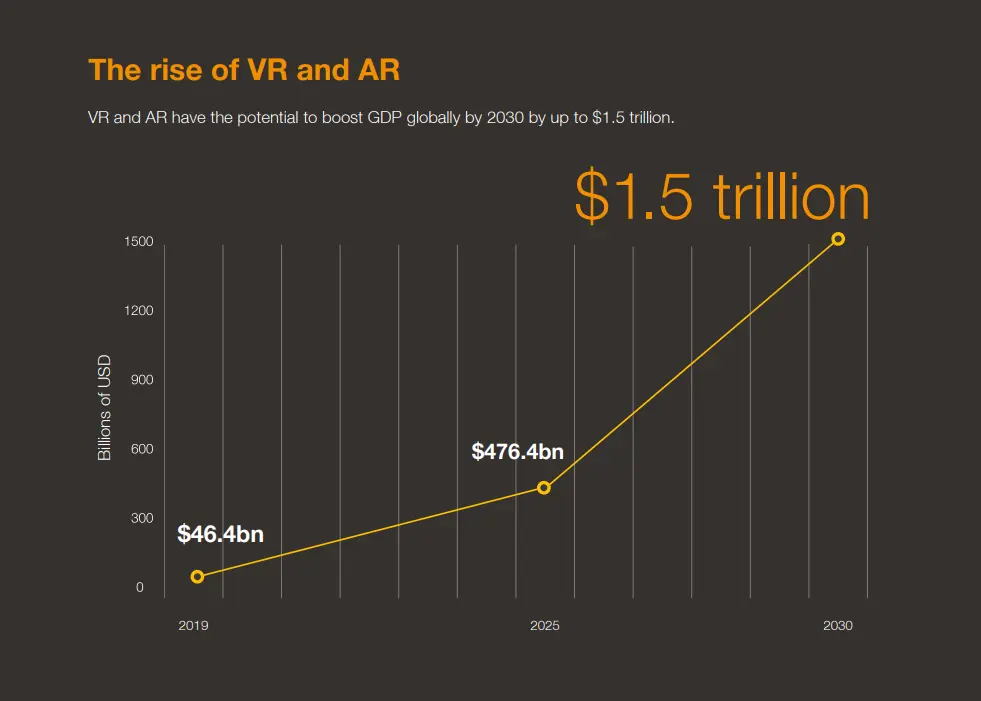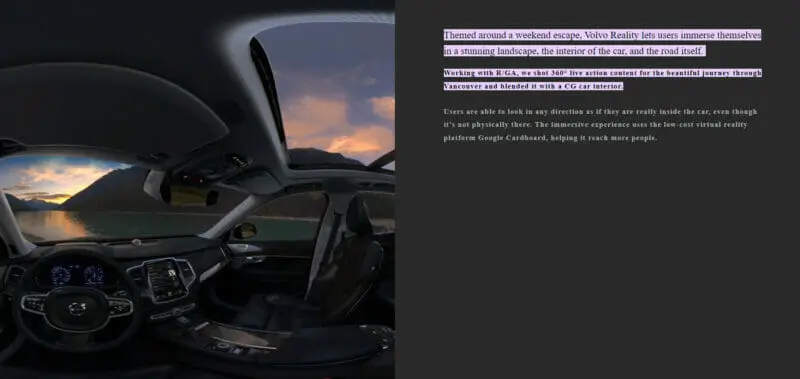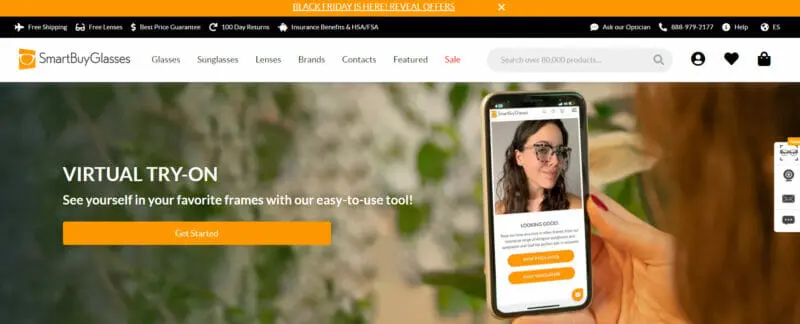Virtual reality is no longer the stuff of science fiction—it’s here and it’s gaining traction fast. With a 2022 market size of more than USD 28 billion, virtual reality is expanding at a steady rate and it’s expected to have a compound annual growth rate of 15% within a 10-year period (2022 to 2030).

Source: grandviewresearch.com
While virtual reality isn’t a new piece of technology, itsl use is expected to grow with time, along with other digital technologies like augmented reality. PwC predicts that by 2030, VR and AR can potentially boost the global GDP to USD 1.5 trillion.

Source: pwc.com
More brands across various industries are adopting such technologies for training their employees, testing new or existing procedures, and developing new products.
Aside from improving efficiency and enhancing operations, businesses are seeing virtual reality as an invaluable tool for marketing. Industries, such as tourism and retail, are using VR to showcase their products to consumers in a novel, more engaging way. Additionally, the entertainment industry is leveraging virtual reality to offer more immersive, interactive, and informative experiences to their target audiences.
Where does marketing fit into all of this? How can virtual reality alter the way brands interact with their target market while opening up opportunities for growth? What does virtual reality marketing have in store for influencers? In this article, we’ll do a deep dive into virtual reality marketing and look at its real-world applications, as well as its benefits for businesses.
The Ultimate Guide to Virtual Reality Marketing in 2024 for Brands and Influencers:
What Is VR Marketing?
Simply put, virtual reality marketing is a marketing strategy that incorporates virtual reality technology in marketing campaigns. It can be used to connect with your audience and build better brand engagement. For example, instead of consumers reading content on the screen, they can interact with a virtual persona.
Branded collectively as immersive media, along with augmented reality, virtual reality marketing offers notable opportunities for businesses to promote their brands, drive sales, and enhance customer loyalty and retention.
Virtual reality creates a realistic, immersive simulation of an environment that plays on multiple senses, which users can access through VR headsets or applications. For example, VR is used to overlay a filter onto a photo or video. Think of Instagram and Snapchat filters. Meanwhile, VR headsets can “transport” users to a 3D virtual environment, enhancing the experience of the simulation. The headset responds to the user’s movements, allowing them to have a good look at the virtual environment (360-degree view) and interact with the various digital elements within the simulation.
How Can VR Help Businesses Grow?
Virtual reality allows businesses to reach out and connect to their potential customers beyond traditional media like TV and magazine ads, presenting limitless opportunities for promotion.
Given that customers’ needs and expectations are constantly evolving, virtual reality technology, or the latest technologies, in general, can help bridge the gap and allow brands to have the means to address their customers’ changing pain points.
Through virtual reality marketing, businesses can create branded digital worlds where they can showcase their products or services. Brands can offer digital experiences in lieu of physical ones. This allows consumers to virtually experience a product or service, taking it for a virtual spin in the comfort of their own homes. By building a realistic digital environment, you’re allowing consumers to interact with your brand, which can help with brand awareness and retention.
Using VR to tell your story
Traditional media like TV and films are great storytelling mediums. However, VR takes storytelling capabilities a step further.
Businesses can use VR to tell their brand stories and market their solutions in a more engaging way. For example, the New York Times used virtual reality to tell the story of how wars affect children in The Displaced.
Through this multimedia experience, users were given an in-depth look into the devastation caused by wars and what it’s like to be a child displaced by such life-changing events. The experience allowed the NYT’s readers to see what’s really happening, making VR and the documentary potent storytelling mediums that provide not only emotional intensity for readers but also a connection with the brand.
Additionally, you can use VR to create novel experiences that allow consumers to view your company in a new light. For example, you can use virtual reality to take customers on a virtual tour of your facility, giving them a rare, intimate glimpse of what goes on behind the scenes. You can show them how you work or what goes on during the design or product development process. This gives a more human angle to your brand and what you’re doing, while helping establish trust and transparency, which can encourage brand loyalty among customers.
Furthermore, because VR tracks a user’s movements, companies can use this to find out how customers might interact with their brands or products in real-world settings. VR can be a valuable resource for data, allowing marketers to create more compelling brand stories.
Creating more memorable experiences
Virtual reality helps consumers better visualize your products and how they can add value to their lives. Instead of merely looking at samples, consumers can use VR to access a digital environment that you’ve curated, allowing you to showcase what you have to offer in real time and how it can potentially be a solution to their needs.
With VR, you can build immersive worlds that provide your target audience with memorable experiences, which can help convert them into warm leads or loyal customers.
Putting the fun in advertising
Traditional ads can get boring fast. They don’t create memorable experiences and some ads, such as pop-ups, can feel spammy and even drive away potential customers.
Volvo, for example, leveraged VR to showcase the Volvo XC90. Through the Volvo Reality app, users can enjoy a virtual reality test drive of the model and get a firsthand look at the car’s interiors.

Source: framestorevr.com
While it’s not exactly using VR technology, Sony’s latest marketing effort with the Morbius 3D billboard in Milan is a good example of how innovative tech can push the boundaries of advertising and reinvent consumer experiences.
While the potential of VR in ads hasn’t yet been fully explored, brands can still incorporate the technology to create better, more memorable experiences for their target audience.
Showcasing your products in a new light
How can you communicate to potential customers that your product is the best solution for their needs? With VR, you can show customers exactly how your product or service can be a part of the solution.
One of the best examples here is Ikea’s Ikea Place app, which lets users try out true-to-scale 3D models of Ikea products and see how a particular piece could work in a given space. The VR-based app allowed Ikea to make solutions more accessible to its clients, allowing them to virtually try out a product before making a purchase.
Virtual reality is an impactful tool that can drive real results when done right. It can help businesses stand out from the competition, while letting them stay at the forefront of the latest innovations. By becoming early VR adopters, businesses can stay relevant in light of recent technological developments.
Marketing Opportunities With VR
Virtual reality marketing can help marketers craft powerful, engaging campaigns that can best communicate your brand story and what you can offer.
Through VR, you can showcase not only existing products but also how new products are being developed. This allows consumers to get a more intimate glimpse of your creation process and can thus be a valuable resource for feedback.
Virtual marketing can help drive emotional engagement.
VR also heralds the advent of improved content marketing strategies and the creation of more intuitive and immersive content. With VR, marketers can reinvent how they deliver experiences by allowing consumers to virtually try on products before purchasing them.
One popular application of virtual reality in the real world is in the real estate industry. Real estate companies and agents can conduct virtual tours, helping buyers to virtually be transported to property and inspect the place for themselves, making them feel as if they’re really there. VR can also be used to showcase a property that’s still in development, which can help buyers see what it could potentially look like once it’s completed and fully furnished.
VR is also making its way to the metaverse with virtual real estate. Metaverse platforms like Sandbox and Decentraland allow users to purchase virtual property and have early access to the metaverse.

Source: news.bitcoin.com
Other industries that extensively make use of virtual reality include retail, tourism, healthcare, and product development.
VR Marketing and Influencers
Influencers are making a huge impact on current marketing strategies and trends. How will emerging technologies like VR affect influencers?
As VR continues to gain traction, it will undoubtedly affect digital marketing strategies. We’re already seeing the rise of AI-powered virtual influencers, which are digital avatars or 3D models that can be found on various social media platforms. These virtual influencers are built by creators and act like their human counterparts.
Many brands, such as Prada and Alibaba, are using top virtual influencers to enhance their campaigns and drive more engagement. Virtual influencers also help brands stay on top of the latest innovations and tap into the interests of their younger audiences. Moreover, like their human counterparts, virtual influencers can help with building brand awareness.

Source: ypulse.com
Where does this leave human influencers?
Human influencers are already embracing virtual reality and augmented reality through app filters, creating branded content in the process and virtual concerts. The advent of immersive technologies will propel influencer marketing to newer heights. This will drive influencers to change up how they create content, taking into account VR and AR technologies through content like livestreaming digital reality interactions or creating 360-degree live content that still allows their followers to interact with them.
How Virtual Reality Marketing Is Changing Brands and Consumer Interaction
Virtual reality connects brands and consumers on a whole new level. It allows businesses to create high-impact product presentations that are tailored for their target market. Brands can incorporate VR into their campaigns to showcase their research and development processes to potential customers. Furthermore, VR allows consumers to actively participate in a brand’s marketing campaign, which can improve brand awareness and recall through deeper engagement on both a mental and emotional level.
Below are some examples of real-world applications of virtual reality:
Immersion as an educational tool
Some companies use virtual reality as an educational tool.
GSK’s “The Excedrin Migraine Experience” shows users what daily life is like for individuals suffering from migraines. The migraine simulator recreates the visual symptoms of a migraine attack, such as auras and light sensitivity. For those of us who haven’t experienced a migraine, it can be difficult to imagine what it’s like. The campaign puts non-sufferers in the shoes of individuals who experience migraines, giving them a glimpse of what migraine sufferers go through, which can help cultivate greater empathy for them.
Another example of using virtual reality for immersion is The Guardian’s 6x9, a VR experience that places users inside a solitary confinement cell and relays the story of how solitary confinement can affect incarcerated individuals.

Source: theguardian.com
To create the experience, the guardian interviewed individuals who were formerly incarcerated, giving them an avenue to share their experiences with the world and paint a compelling portrait of the psychological effects of prolonged solitary confinement.
Reinforcing the “try before you buy” concept
Allowing users to try on a product before a purchase helps them make more informed decisions. Companies are using VR to let users try on clothes, makeup, accessories, and even furniture without going to a physical store.
Walmart is using an AI-powered virtual try-on technology for consumers who are shopping for clothes online. This feature uses AI technology such as real-time image processing ad deep learning to create a simulation that helps buyers see what clothes would look like on them. Users can select a model that closely matches their height and size and use that to virtually try on a range of Walmart’s clothing offerings.
Glasses are also big on the virtual try-on trend. EyeBuyDirect lets users virtually try on a range of eyeglasses and sunglasses using their phone or by uploading their photos (if they’re unable to use their phone cameras).
Similarly, SmartBuyGlasses also has a virtual try-on feature that lets customers find the perfect frame by taking a selfie video or visiting the website and searching for glasses that are available for virtual try-on.
VR is redefining user experience
As we’ve previously discussed, VR can be an invaluable storytelling tool.
HBO, through VR, transports Game of Thrones fans to an immersive simulation of Westeros by giving them two unique VR and mixed reality experiences—The Dead Must Die: A Magic Leap Encounter and Beyond the Wall: A Game of Thrones VR Experience.
In The Dead Must Die, fans don a Magic Leap headset that transports them to a simulation of the icy North, giving them the opportunity to confront a White Walker and try to defeat it using a dragonglass dagger.

Source: makinggameofthrones.com
In Beyond the Wall, fans wear an HTC Vive headset that allows them to see and feel what it’s like to be a Night’s Watch ranger stationed at the Wall. To complete the experience, fans step into a replica of the Wall’s elevator.
Virtual Reality Marketing Here and Now
Virtual reality isn’t just for games and entertainment. It’s a powerful and versatile tool that has made its way to the marketing industry. Early adopters are already using virtual reality to deliver new ways of promoting content, allowing them to create engaging and memorable content for their audiences. While we have yet to see its full potential, how virtual reality is currently being used by different brands and industries can give us a preview of what this emerging technology is capable of.
Frequently Asked Questions
What is virtual reality marketing?
Virtual reality marketing is simply marketing that makes use of emerging virtual reality technology to offer new experiences to consumers.
How can virtual reality marketing benefit brands?
Virtual marketing can help businesses stay relevant, keep up with the latest technological trends, and maintain a competitive edge. It’s a valuable tool that can grab the attention of your audience, while allowing you to offer personalized experiences. It’s a piece of technology that’s scalable, which means that even companies with limited budgets can use it for their virtual marketing campaigns. Moreover, virtual reality improves not only consumer engagement but also team productivity by reducing the workload of your sales team, for example, because VR can help consumers examine and learn more about a product without the help of sales associates.
Which companies are already using virtual reality technology in their marketing campaigns?
Many global enterprises are already incorporating virtual reality into their marketing campaigns, such as:
- Ikea
- TOMS
- L’Oréal
- Gucci
- Adidas
- Lowe’s
- Wendy’s
- GSK
- The New York Times
- Volvo
- McDonald’s






